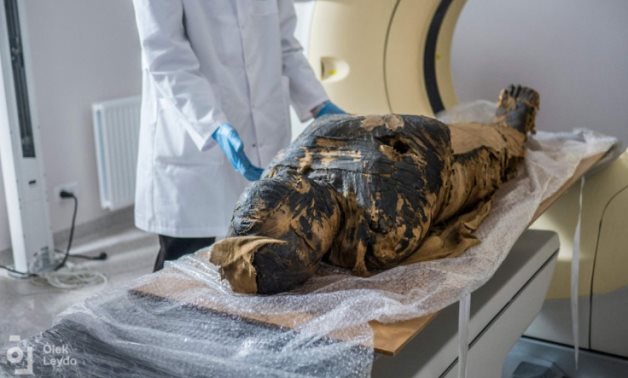
The allegedly pregnant ancient Egyptian mummy - Photo by Olek Leydo, courtesy of the Warsaw Mummy Project
CAIRO – 2 August 2022: The life of ancient Egyptians remains the focus of researchers and scientists around the world. Every now and then a new study appears shedding light on a discovered artifact or a mummy of a king or a queen.
A recent study conducted by Polish scientists on the ancient Egyptian mummy displayed in the Warsaw Museum, and known as the "Pregnant Mummy", revealed astonishing information.
In May 2021, it was published in the Journal of Archaeological Sciences that an X-ray was performed on the mummy of an Egyptian woman. X-rays showed that the remains of a woman who died 2,000 years ago contained a fetus. X-rays also showed that the woman died when she was between 20 and 30 years old.
The fetal head was measured to ascertain the number of weeks the woman had been pregnant. The researchers found that the mummy was between 26 and 30 weeks pregnant when she died.
In 2022, Sahar Selim, professor of radiology at Cairo University and an expert on mummies, revealed a new surprise about the mummy. Selim confirmed that the mummy's pregnancy is "false". Selim's scientific reply was published in the same scientific journal that published the Polish research in January 2022, after having been approved by 3 specialized arbitrators.
Selim refuted that the presence of a fetus inside a mummy had been witnessed before, as it is incompatible with the Egyptian methods of embalming. She added that these results contradict the natural stages of decomposition and the mummification process, according to the method used by the ancient Egyptians.
Selim's detailed response confirmed that the pregnant uterus is a very fertile material for bacteria. The presence of bacteria leads to decomposition after death and the survival of the pregnant uterus inside the mummified body leads to the inevitable decomposition of the body.
For the same reason, ancient Egyptian embalmers always removed the internal organs, and would not have left a womb carrying a fetus inside the body, so as not to damage the corpse. The hypothesis that the embalming salts (natron) outside the womb preserved it is a false hypothesis, as salts are never sufficient to preserve the fetus inside the womb or prevent it from rotting.
From the examinations of thousands of ancient Egyptian mummies preserved in Egypt and in museums around the world, no scientist has ever found a pregnant uterus inside a mummy. The mass in the womb of this mummy cannot be considered a fetus because it completely lacks any structural or anatomical characteristics of a fetus and does not contain any bones.
The Polish study considered that the oblique semi-circular part is the head of the fetus, and this seems to be a false hypothesis. It is unlikely that the spherical shape is the head of a fetus because the bones of the fetus's skull are not fused, so the skull must collapse and the fetal head cannot retain the spherical shape as in the results of the research.
The Polish team justified the absence of any bones inside the mass. They alleged bones shrunk and faded and nothing was left of them. Selim responded that bones of fetuses do not fade, and that archaeologists found many skeletons of fetuses in ancient Egyptian cemeteries, such as the cemetery of Kellis II in the Dakhleh Oasis, and the smallest of them was for a 20-week-old fetus.
In January 2022, the Polish team justified that the preservation of the fetus and the fading of its bones was done through the “pickling” theory, claiming that the acids resulting from the decomposition of the uterus caused the erosion of the fetus’s bones.
Egyptian Abla Attia replied that the pH resulting from the decomposition after death is not strong enough to completely dissolve the bones of a fetus. Moreover, Attia explained that embalming salts are not enough to stop the spread of decomposition and its transfer from the decomposing uterus to the surrounding tissues, which leads to the inevitable decaying of the body.
In July 2022, the Polish team admitted the false pregnancy.
The research team published a new finding in the Journal of Archeology and Anthropology to clarify that what was found in the entrails of the mummy was actually some linen fascia present in the mummy’s basin, not an embryo.
The director and founder of the Warsaw Mummy Project decided to re-examine the CT scan of the allegedly pregnant mummy. The advice of Selim and the radiologist Lukas Kaunke, as well as the head of the Department of Restoration and Conservation at the Warsaw National Museum was sought, along with the advice of other researchers.
Through the CT images, the contents of the pelvis are clearly visible. Comparative studies were conducted with the ancient Egyptian fetuses, such as the embalmed fetuses of Tutankhamun's daughters that Selim examined.
Camilla, the director and founder of the Warsaw Mummy Project, stated that she and her co-students did not find a fetus in the pelvis at all - as the authors of the 2021 report claimed. What was found were four scrolls placed by embalmers, and this is a well-known practice in ancient Egypt to preserve the shape of the body after it was separated from the viscera during the mummification process.
Comments
Leave a Comment